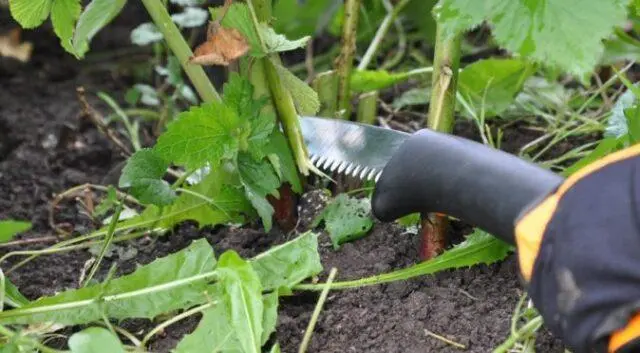Contents
Black Butte blackberry is an American variety, characterized by very large, sweet berries (weight reaches 20 g). It withstands frosts down to -20 degrees, so the crop can be grown in different areas of the Central Region. The variety is demanding on watering and top dressing.
History of origin
The Black Butte blackberry is an American hybrid developed by breeder Chad Finn of the Agricultural Research Service at the Department of Agriculture. The work was carried out at the experimental station in Corvallis (Oregon, Northwest USA).
Blackberry Black Butte was widely used already in 2000. In Our Country, it appeared a few years later, it was imported from Ukraine. The variety is not included in the register of breeding achievements, but is known to many summer residents and farmers. There are several names in the domestic literature:
- Black Butte;
- Black Bute;
- Black Butty;
- Black Bat.
Description of blackberry variety Black Butte
Black Butte is a shrub with powerful shoots creeping along the ground (length 3–4 m). The branches are quite flexible, do not break, covered with small black spikes along their entire length. The bush is moderately spreading. Roots are well developed, basal shoots are absent.
The leaves are bright green, with a corrugated surface, the edges are notched. The shape of the plate is a trefoil. Black Butte blackberry bears fruit on the last year’s shoots. Fruit branches appear in the amount of a maximum of 5-6. Berries are formed in 4-5 pieces on one brush.
They are elongated, have a black color with a bluish tint. The sizes are atypically large: up to 5 cm long, average weight 12–15 g, specimens up to 20 g often come across. The pulp is juicy, the taste is pronounced sweetness and slight sourness.
Characteristics of Blackberry Black Butte
Black Butte blackberry is characterized by sufficient winter hardiness, which allows it to be grown not only in the south, but also in certain areas of the Central region (for example, in the Lower Volga region). At the same time, the bushes prefer abundant moisture – prolonged drought has a bad effect on the crop. Therefore, in the hot period, it needs regular watering.
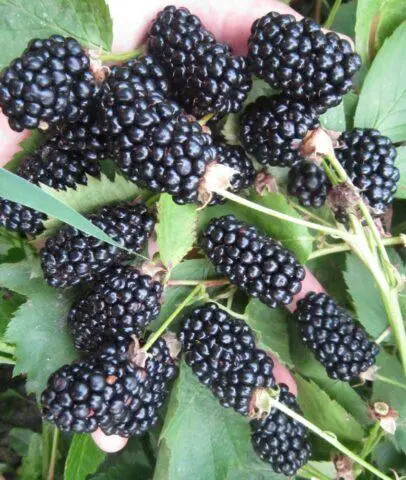
Berries from Black Butte blackberries appear from June to the end of July
Ripening time and yield
Bushes begin to bloom in mid-May. The berries ripen in about 1–1,5 months. Therefore, the variety belongs to the early ones. Fruiting is extended, on average it lasts 6-7 weeks, during which all the fruits are harvested.
The yield is quite high. Subject to the basic rules of care, 3–3,5 kg of blackberries are harvested from one bush, sometimes up to 4 kg. The fruits are used fresh. They are suitable for various dishes and preparations (pastries, jam, jam, cake decoration).
The keeping quality of Black Butte, like other blackberry varieties, is low. In the refrigerator, berries are stored for no more than 1-2 days. Therefore, they must be consumed fresh or used for preparation of blanks. Shock freezing is allowed, which will preserve useful substances.
Winter hardiness of Blackberry Black Butte
Black Butte belongs to winter-hardy varieties – it withstands frosts down to -29 ° C, which corresponds to zone 5. These are the regions of the Lower Volga region, the Black Earth region and all southern regions, including the Krasnodar Territory, the North Caucasus and others. There is evidence that bushes normally tolerate frosts down to -18 ° C. If winters are colder, then the culture must be covered (especially if it has been planted recently).
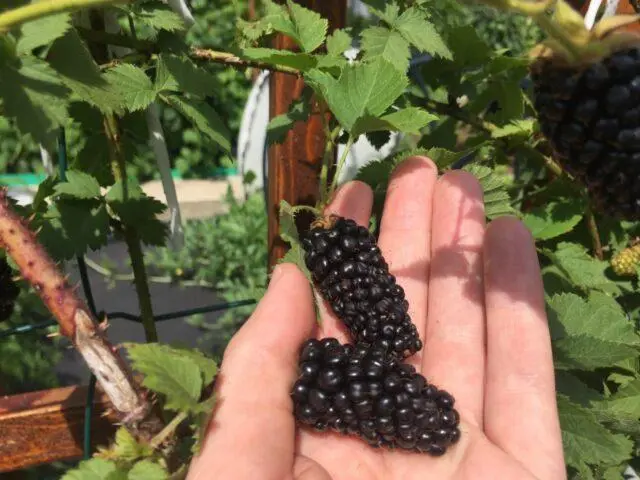
Black Butte can be grown in different regions of Central Our Country
Disease and pest resistance
Blackberry Black Butte is distinguished by good resistance to most diseases and pests. Bushes can suffer from gray rot. This is a fungal infection, the signs of which are rotten berries with a white coating. Also, brown spots appear on the apical shoots, pressed inwards. This phenomenon is especially common during the flowering period of blackberries (May and early June).
As a preventive measure, you need:
- Raise the creeping branches of the Black Butte blackberry above the ground.
- Periodically cut off the shoots, avoiding thickening of the crown.
- Harvest early.
- Periodically inspect plants, remove affected leaves, branches and burn them.
On the eve of flowering (end of April), all bushes are recommended to be totally treated with Bordeaux liquid or another fungicide:
- “RAW”;
- “Quadris”;
- “Score”;
- “Topaz”;
- “Ordan”.
During the growing season, pests can settle on Black Butte blackberry bushes:
- spider and blackberry mites, which often leads to the loss of up to half of the crop);
- bear (digs roots);
- Chafer.
Folk remedies are used to kill insects (for example, an infusion of tobacco dust, wood ash with laundry soap, a decoction of marigolds, potato tops). If this does not help, the bushes are treated with insecticides:
- “Thiovit Jet”;
- “Decis”;
- “Karate”;
- Carbophos;
- “Inta-Vir”;
- “Spark”.
Advice! For the treatment of Black Butte blackberry bushes during fruiting, it is better to use biological preparations, for example, Vertimek, Fitoverm, Bitoxibacillin and others. You can harvest 3-5 days after spraying.
Pros and cons of the variety
Blackberry Black Butte is valued by summer residents and farmers for a good harvest, tasty and large berries. The variety has a number of advantages, which allows you to successfully grow berries both for yourself and for sale.
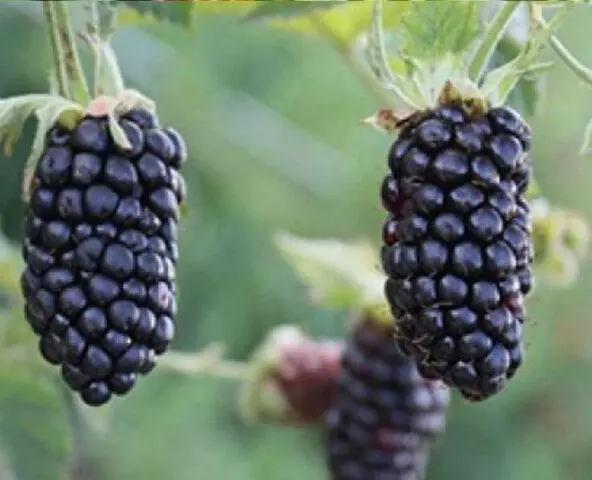
Blackberry Black Butte produces very large marketable berries
Pros:
- consistently high yield;
- pleasant taste;
- bushes are not demanding on the soil;
- early ripening;
- universal purpose;
- disease resistance.
Cons:
- average winter hardiness, the plant needs shelter;
- bushes grow strongly, pruning is required;
- too many thorns – difficult to care for and harvest;
- low keeping quality;
- watering requirements.
Rules of landing
Blackberry seedlings are purchased from nurseries or suppliers. Landing can be done in early May (in the south – in October). Night temperature should not fall below +12 °C. For planting choose an open area with fertile, light soil. A month before planting, compost is added to it (a bucket per 1 m²) or complex mineral fertilizer (30–40 g per 1 m2).
Landing rules are standard:
- In a few weeks, it is necessary to prepare pits of the same depth and diameter (40×40 cm) with an interval of 80–100 cm from each other.
- Small stones fall asleep at the bottom.
- On the day of planting, seedlings are soaked in a solution of a growth stimulator (“Kornevin”, “Heteroauxin”).
- Planted plants, sprinkled with fertile soil, tamping it a little.
- Pour out a bucket of settled water.
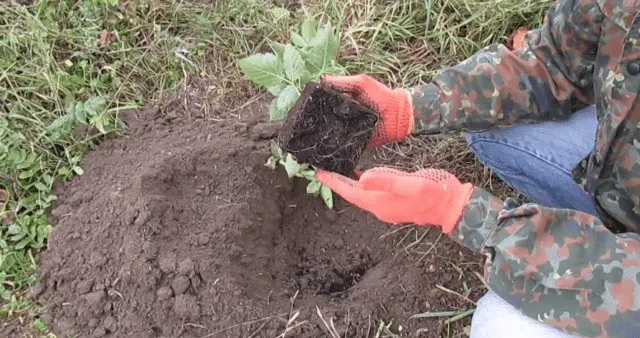
Optimal soil – fertile, loose loam
Care
When growing Black Butte blackberries, special attention is paid to watering. If there is no rain, they give 1-2 buckets weekly (in drought – 2 times more often). In this case, the soil should not be too wet or waterlogged. Fertilizers begin to be applied from the second season:
- in April, urea is used 15–20 g per bush;
- during flowering, rotted compost and an infusion of wood ash are needed;
- a week later – superphosphate (40 g per bush) and potassium salt (20 g per bush).
The soil is regularly loosened, weeded. For the winter, sawdust, peat, spruce branches and other mulch are laid on the ground. In regions with a cold climate (below -20 degrees), young seedlings are recommended to be wrapped with agrofibre.
Due to the abundance of moisture, the berries of this variety will become more watery, they will increase in size, but this will have a bad effect on the taste.
Formation of Blackberry Black Butte
Bushes grow strongly, and branches spread along the ground. Therefore, the blackberry Black Butte needs to be shaped. Do it gradually:
- As soon as the upright shoots grow to 40 cm, they are bent over and pinned to the ground.
- After they grow to 1 m, the mount is removed and fixed to the trellis.
To make the bushes compact, do not take up much space, they act in this way:
- In a seedling at the age of 1–2 years, pinch the top point of growth in July (as soon as the shoot reaches 1 m) to stimulate the appearance of side branches.
- In early April, before the buds swell, all low side shoots (up to 40 cm) are removed, and the higher ones are cut off – then they will grow even faster.

- All branches that have given up the harvest are removed closer to frost (early October).
Methods of reproduction
Black Butte strawberries can be propagated by layering. The procedure starts at the beginning of August. Sequencing:
- Outline several young green shoots, remove their apical parts (by 2 cm).
- Step back 15 cm and remove all leaves below this mark.
- Bend the branch and pin it to the ground.
- Sprinkle with fertile soil the part that was left without leaves.
- In early October, carefully mulch with spruce branches, sawdust or other material.
- For the next spring, organize enhanced care – top dressing, watering.
- A year later (i.e., for the second season), separate the cuttings from the mother blackberry bush Black Butte with a shovel or knife and plant it in a new place. Water and mulch again for the winter.
Conclusion
Black Butte blackberry is a variety that has not yet become widespread in Our Country. It is suitable for lovers of large and sweet berries. The fruits are used both fresh and in various preparations for the winter.











